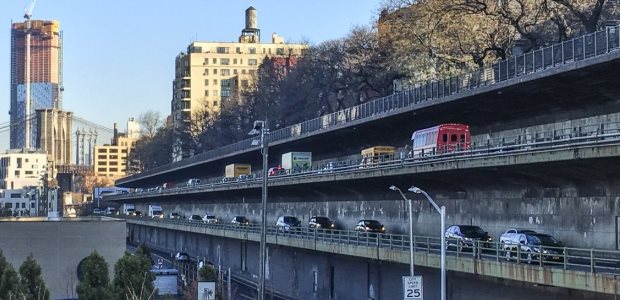
Expert Panel to Evaluate BQE Reconstruction Options
The Brooklyn-Queens Expressway's 1.5-mile section between the Atlantic Avenue Interchange and Sands Street is one of the most complex highway structures in the country. Built in 1954, it includes a triple-cantilever structure, of which the Brooklyn Heights promenade is the top tier.
New York City Mayor Bill de Blasio has appointed a panel of experts to evaluate the options for replacing the aging Brooklyn-Queens Expressway (BQE) from the Atlantic Avenue interchange to Sands Street in Brooklyn, with Carlo Scissura, president and CEO of The New York Building Congress, serving as chair. The panel includes leaders in the fields of urban planning, engineering, construction, traffic modeling, and historic preservation. They will consult community groups and elected officials and evaluate all suggested concepts, as well as provide their own perspectives, and are expected to conclude the process by this summer.
The mayor's April 3 announcement said the environmental process for the BQE reconstruction will take their recommendations into consideration when it begins at the end of 2019.
"The BQE is a lifeline for Brooklyn and the entire city, which is why we are bringing in a panel of nationally renowned experts from a range of fields to vet all ideas and make sure we get this right," said de Blasio. "We will be engaging in a transparent, collaborative process to find the best solution for one of the most critical transportation corridors in the nation."
The expressway's 1.5-mile section between the Atlantic Avenue Interchange and Sands Street is one of the most complex highway structures in the country -- it includes a triple-cantilever structure, of which the Brooklyn Heights promenade is the top tier. Originally built by Robert Moses, the road was completed in 1954 and carried fewer than 50,000 vehicles daily when it opened. But today, the road is part of Interstate 278 with daily traffic exceeding 150,000 vehicles, including more than 15,000 trucks.
According to the announcement, an evaluation by outside consultants hired by the New York City Department of Transportation concluded in 2016 that if the road is not reconstructed by 2026, weight restrictions may need to be added to the structure, including diverting all truck traffic to local roads.
In 2018, a state law was enacted that will allow the BQE project to be constructed using the Design-Build method, which is expected to save time and money.
The expert panel will begin meeting this month.
"Community members and stakeholders across the city have come together to propose new ideas and call for fresh thinking on the BQE, the biggest such project the city has ever undertaken," said DOT Commissioner Polly Trottenberg. "This new panel presents an important opportunity to create the best plan possible, with community voices heard throughout the process. We also thank the elected officials who have been and will doubtless remain actively engaged as we move forward."
"I must express my sincerest appreciation to Mayor de Blasio and his administration for entrusting me with this critical role," said Scissura. "The panel that has been assembled represents the absolute best minds in urban planning, transportation, business, design, engineering, and construction and will create a thoughtful, meaningful, and inclusive process. Rebuilding the triple cantilever will affect every community along the BQE – as well as the tens of thousands of commuters that drive on it daily – and it is essential that we come together to ensure this project is done right for each individual neighborhood and all five boroughs. I look forward to working with our incredible DOT Commissioner Polly Trottenberg, the panelists, and the residents of New York City to produce an outcome that is in the best interests of everyone."
"How best to reconstruct the BQE has been a tremendous local transportation challenge for some time," said U.S. Rep. Nydia M. Velázquez. "I'm pleased to see the formation of this panel, which will help ensure the full universe of options are fairly considered and vetted from a wide range of perspectives. It is imperative that the panel is committed to ensuring the community is fully engaged and stakeholders will provide frequent, meaningful input throughout the process. Overall, I believe this is a positive step that will bring additional transparency to a project that has wide ranging impact on our local neighborhoods and entire city."